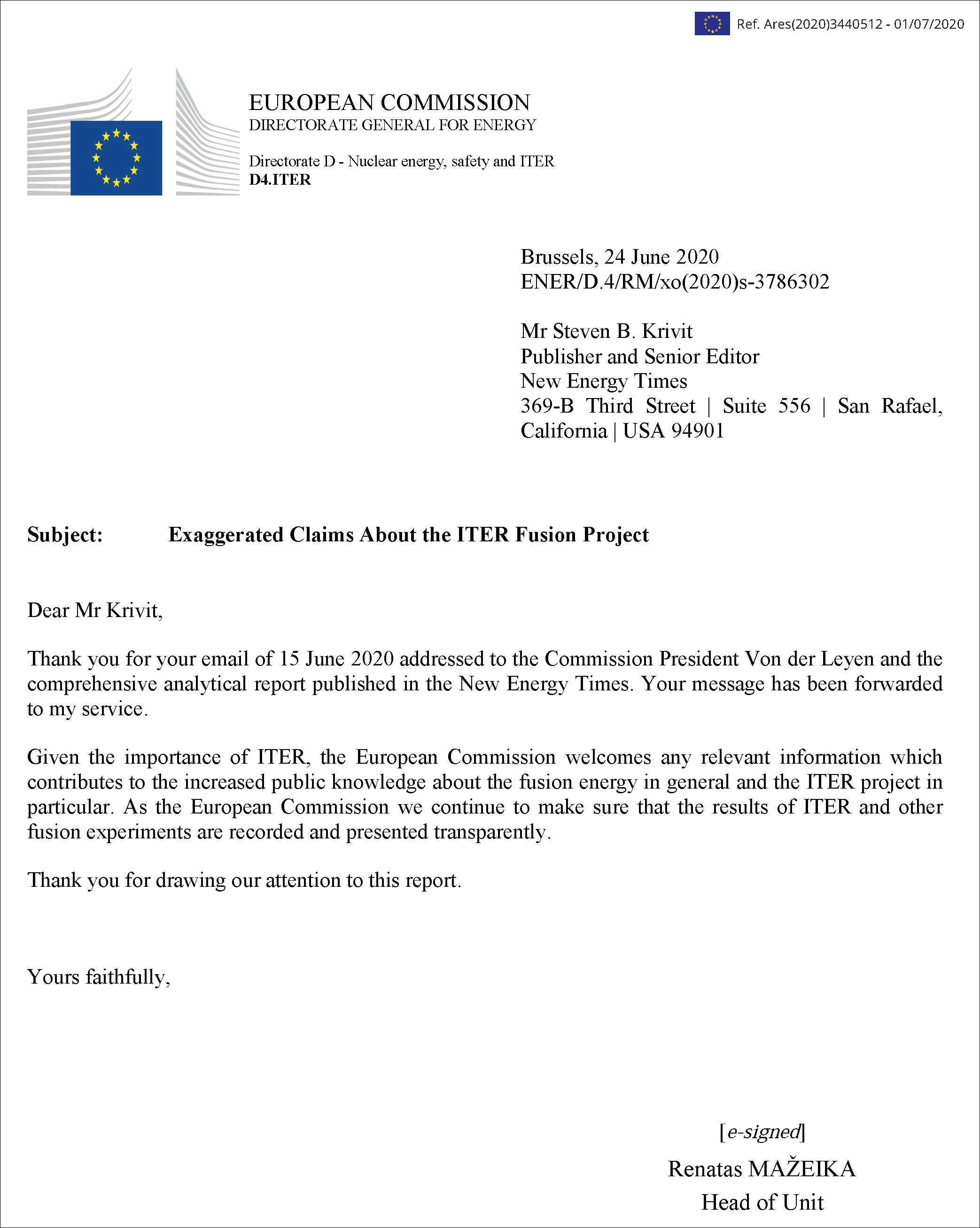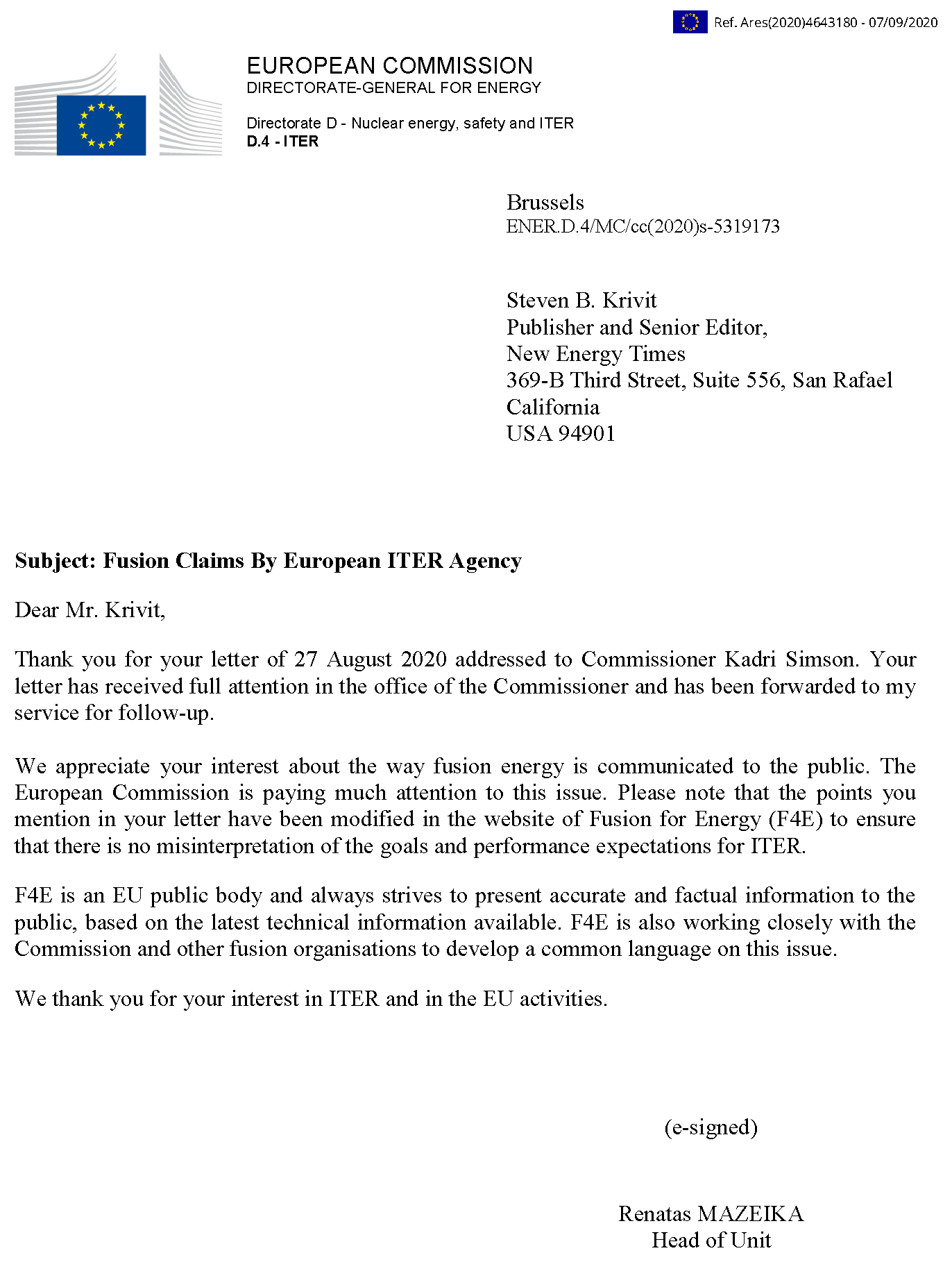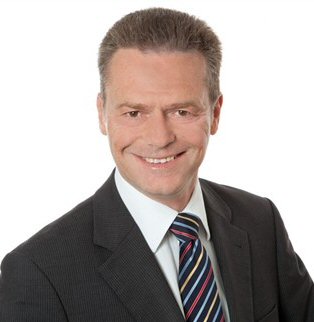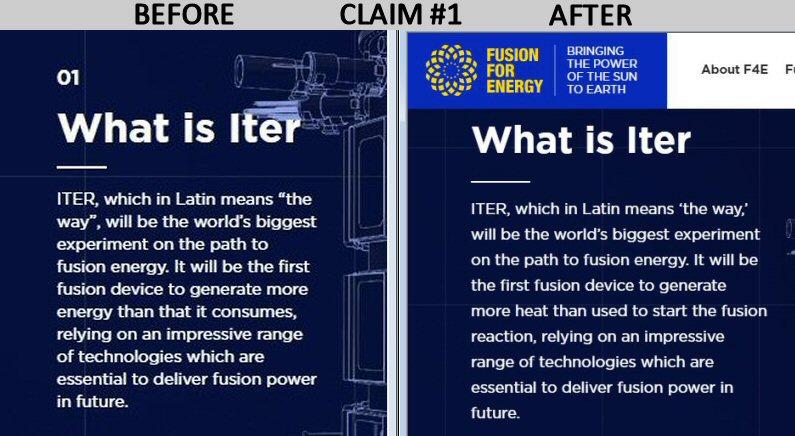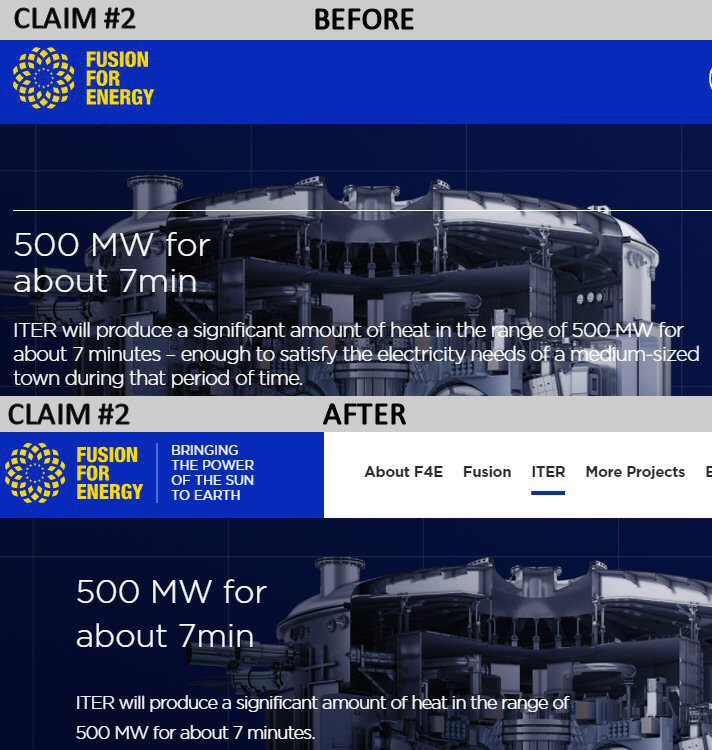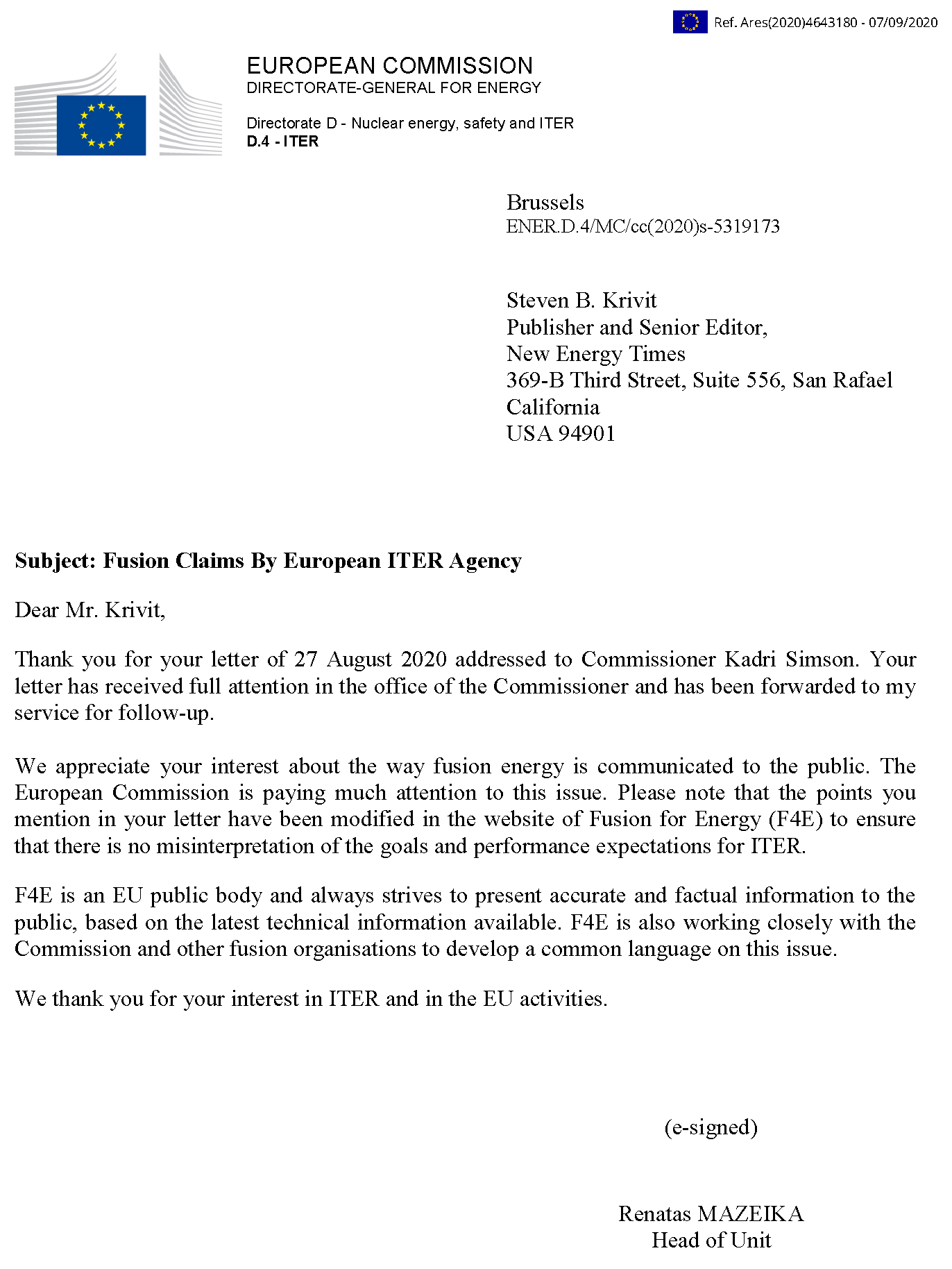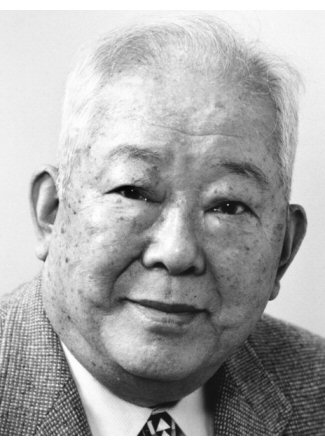Return to ITER Power Facts Main Page
Originally Published: Sept. 26, 2020
Updated: Oct. 2, 2023
Steven B. Krivit
This page contains a listing of international science, government, and industry organizations that have corrected their false or misleading ITER power claims after I contacted them.
In a nutshell, the ITER reactor is designed for a net power gain across the plasma, not across the entire reactor. The “50 MW” and “500 MW” values always were associated with the plasma gain, but ITER’s promoters said or implied that those values were associated with the entire reactor.
Organizations that have made corrections include the ITER organization, the ITER domestic agencies in Russia, India, South Korea, the U.S., and Europe. They include EUROfusion, the World Nuclear Association, the European Commission, Institut de Radioprotection et de Sûreté Nucléaire, the U.K. Atomic Energy Authority and Culham Centre for Fusion Energy, the International Energy Agency, the European Parliament, FuseNet, the Atkins Company, and the Princeton Plasma Physics Laboratory.
ITER Organization (Bigot Regime)
I wrote to Bernard Bigot, the director-general of the ITER organization headquarters on May 1, 2017. He did not respond or make any corrections. I published the correct required electrical input power rate for the ITER reactor on Oct. 6, 2017. I wrote to Bigot on Oct. 13, 2017, and told him about my report. Less than a month later, Bigot and his staff made some corrections. Notable among them was the page of “Facts and Figures,” provided for members of the news media. The “500 MW” section was significantly corrected.
On March 6, 2018, Bigot testified before Congress. On March 28, 2018, I reported misleading claims he made at that hearing. Several hours after I published my report, his staff made more corrections on the ITER organization’s Web site.
I wrote to Bigot again on June 17, 2018, and encouraged him to make further corrections. To my knowledge, he did not made further corrections and continued to make prominent misleading claims about the goal and planned result of ITER.
On July 28, 2020, Bigot and his team published a press release with a blatant false claim about ITER’s expected power output.
EUROfusion
On Oct. 11, 2017, I notified Petra Nieckchen, the head of media relations for EUROfusion, that three Web pages on the organization’s Web site contained false claims about ITER. Nieckchen wrote back to me but was not willing to make corrections yet. She wanted to wait until her organization redesigned their Web site.
I wrote to Nieckchen again on Nov. 21, 2017, and made sure she understood that she and Tony Donné, the EUROfusion programme manager, were making false science claims. I advised them to act promptly. I sent copies of my letter to the scientific leaders who compose the EUROfusion Consortium. Two days later, EUROfusion made complete and precise corrections.
Five months later, in April 2018, EUROfusion redesigned its Web site and, in doing so, removed all of the pages it had corrected in November 2017. EUROfusion also removed its entire ITER Web page, leaving no trace of its accurate descriptions of the expected power output of ITER.
Donné is also a part-time professor at Eindhoven University of Technology, as are Roger Jaspers and Niek Lopes Cardozo, the two founders of FuseNet. (See below)
World Nuclear Association
I contacted Agneta Rising, the director-general of the World Nuclear Association, on Oct. 13, 2017, and informed her that her organization was making a false claim about ITER. One of her staff members said they would attend to the matter in the following week. They didn’t.
On Nov. 8, 2017, after Rising’s staff had made no corrections, I sent another e-mail to Rising and informed her that the ITER organization had made some corrections to its Web site. Rising thanked me for the information and made no corrections.
On Nov. 28, 2017, I sent another e-mail to Rising, and I suggested corrective text. Her staff made corrections to the WNA Web site the next day, including a disclosure of the required input power for the reactor.
On Dec. 11, 2017, I published a report listing, among other items, the Nov. 29, 2017, correction by WNA. Nine days later, on Dec. 20, 2107, WNA removed the sentence containing the required input power requirement for ITER. This was my first indicator that the fusion community was going to suppress the actual amount of power required to operate the ITER reactor, which I had revealed.
Removal of the 300 MW electrical input value resulted in a misleading statement by WNA. On Dec. 20, 2017, I explained this to Rising and said that, if she was not going to inform readers of the required input power requirement for the reactor, then she must inform readers that she is giving values of only the plasma thermal output and plasma thermal input. Her staff fixed the WNA Web site within 48 hours. The change log is here, in the World Nuclear Association section.
ITER Russian Federation Domestic Agency
I wrote to Anatoly V. Krasilnikov, the director of the ITER Russian Federation domestic agency for the first time on Dec. 17, 2017. I told him about the false and misleading claims on his organization’s Web site. He didn’t reply to me by e-mail. But he did fix one of the problems. I wrote to him again about the remaining problems. A few months later, he made one correction but allowed other false claims to remain. I wrote to him again. A few months later, he removed another one of the false claims and replaced it with a new one. This went on for three years. Eventually, he removed all of his prior inaccurate claims and, in their place, copied and pasted the “net energy” claim from the ITER organization’s Web site. I wrote to Krasilnikov again and asked whether he would like to correct his new false claim. In response, he added the ITER organization’s false definition for the false claim. I wrote to him again on Sept. 15, 2020. According to Archive.org, sometime between Sept. 19, 2021, and Oct. 25, 2021, the Russian ITER domestic agency removed all of its English pages. The change log is here, in the Russia section.
ITER India Domestic Agency
On Dec. 17, 2017, I wrote to Shishir P. Deshpande, the ITER India project director, about false and misleading claims on his organization’s Web site. He wrote back to me the next day: “Thank you for your message. We will take appropriate action.” On Jan. 31, 2018, he wrote back to me: “The information on the ITER-India website has been updated.” It was corrected. Completely. And it remained so. The change log is here, in the India section.
ITER Korea Domestic Agency
I first wrote to Kijung Jung, the director of the ITER Korea domestic agency, on Dec. 17, 2017, about two of his Web pages with false and misleading claims. I wrote to him a total of five times. He wrote back once and made incremental corrections to the ITER Korea Web site each time. Eventually, he arrived at claims that were mostly accurate and transparent for a public audience on one page and claims that were “only” misleading on the other page. The change log is here, in the Korea section.
European Commission
On Feb. 16, 2018, I wrote to Jean-Claude Juncker, at the time the president of the European Commission, about the two false and misleading claims about ITER on a European Commission Web site. On March 1, 2018, Telmo Baltazar, a senior political adviser for Juncker, wrote back and said that Maroš Šefcovic, the vice-president responsible for Energy Union, would address the issues. On April 6, 2018, the European Commission updated its fusion Web page with partially corrected statements. However, the commission continued to publish the misleading claim that the ITER reactor was designed to produce “500 million Watts of fusion power” without explaining the hidden meaning of the phrase “fusion power.”
In May 2020, l learned that the commission removed its misleading claim that “ITER will be the first experiment to generate up to 500 million watts (MW) of fusion power.” The commission replaced the claim with one that is accurate and transparent: The goal of ITER is “to prove the scientific and technological feasibility of fusion as a future energy source.”
I found one other current document on the commission’s site that contained a false ITER claim, and following my suggestion, the commission corrected the text on August 14, 2020.
Although the European Commission, to my knowledge, has corrected all of its current Web pages and documents with claims about ITER, the commission was one of the few organizations that initially argued with me. In three years, I exchanged about 30 letters with a variety of officials in the commission. The language in many of the earlier letters was technical, nuanced and misleading. The letters seemed to be ghostwritten by ITER stakeholders in the science community. The most current status and change log is here.
Many older European Commission documents contain false or misleading ITER claims. Initially, I brought these to the attention of the European Commission, but since these pages are more archival in nature, neither the commission nor I have pursued corrections on such documents. They are listed here in the European Commission section.
Institut de Radioprotection et de Sûreté Nucléaire
On June 17, 2018, I wrote to Jean-Christophe Niel, the director-general of the Institut de Radioprotection et de Sûreté Nucléaire, about a false ITER claim on its Web site. He did not write back, but 10 days later, he made the correction, although he missed the distinction between external power consumed by the heating systems and injected power delivered by the heating systems. The change log is here, in the Energy Organizations section.
U.K. Atomic Energy Authority and Culham Centre for Fusion Energy
On June 17, 2018, I wrote to Nick Holloway, the media manager for the Culham Centre for Fusion Energy, about false and misleading claims on the CCFE Web site. Three days later, he wrote back to me and made a correction. His correction was insufficient, and I wrote back to him. After an additional three days, he wrote back and made the necessary correction.
In 2020, CCFE published on its Web site a new page with a false claim. I wrote to Holloway on Jan. 22, 2020. Two weeks later, he wrote back to me and made the necessary correction. The change log is here, in the United Kingdom section.
International Energy Agency
On June 17, 2018, I wrote to Fatih Birol, executive director of International Energy Agency, about false ITER claims on his organization’s Web site. He did not write back, but he stripped the page of the false claim and later removed the page entirely. The change log is here, in the Energy Organizations section.
European Parliament
On June 17, 2018, I wrote to Anthony Teasdale, the director-general of the European Parliamentary Research Service, about a briefing prepared for members of the European Parliament titled “How the EU Budget Is Spent.” It contained false claims about JET and ITER. Teasdale made two rounds of incremental and incomplete corrections. When I encouraged him to make full corrections, he consulted with Laban Coblentz, the spokesman for the ITER Organization, and in his response to me, Teasdale cited Coblentz’ explanation for why the text was sufficient.
Coblentz convinced Teasdale to keep the misleading claims. One was that the overall JET reactor (not just the plasma) produced 16 MW of thermal power from only 24 MW of thermal power. This claim omitted the 700 MW of electrical power that was used by the reactor. The claim also relied on the hidden double meaning of the phrase “fusion power.” The other claim was that, for ITER, the overall reactor is designed to produce 500 MW of output thermal power from only 50 MW injected thermal power. This claim omitted the 300 MW of overall electrical power that will be needed by the reactor. I suspended further attempts to advise the European Parliament. The change log is here, in the European Parliament section.
FuseNet
The correction at FuseNet, the European fusion education association, was one of the most important ITER corrections because the organization directly influences students. As I have reported elsewhere, the newest generation of young fusion scientists has grown up thinking that ITER will need only 50 MW to operate and that JET needed only 24 MW to operate. Students include those at Stanford and Princeton, and even include Ian Chapman, now the director of the Culham Centre for Fusion Energy, a former student of the previous director, Steve Cowley.
FuseNet had been providing students false information about ITER’s purpose and output for eight years. My initial contact was with Roger Jaspers, the chairman of FuseNet, on June 17, 2018. It took six months and three letters from me to get Jaspers to make the first corrections on two of the three pages with false claims. It took another six letters, and the attention of the FuseNet Board of Governors and FuseNet Academic Council, to convince Jaspers to make the final correction which happened in January 2019. The change log is here, in the FuseNet Association section.
Jaspers is also an associate professor at Eindhoven University of Technology (as is Tony Donné, the head of EUROfusion). FuseNet was founded by Jaspers and another Eindhoven professor, Niek Lopes Cardozo. Cardozo was the founding chair of the board, from 2010 to 2014 and is no longer listed as board member. Jaspers was the chair of the board from 2015 to 2019 and is no longer listed as board member.
Atkins Company
On Sept. 25, 2018, I wrote to Richard Lyall, the nuclear major projects director for the Atkins company. Atkins is responsible for building part of the ITER infrastructure and was awarded a €150 million contract from Fusion for Energy. I advised Lyall of the false and misleading claims about JET and ITER on his company’s Web site. He did not write back, but a month later, Lyall removed both claims. The change log is here, in the Industry section.
Princeton Plasma Physics Laboratory
The Department of Energy’s Princeton Plasma Physics Laboratory (PPPL) has also made false claims about ITER and its own, now-decommissioned TFTR reactor. John Greenwald, a science writer for the PPPL public relations office, as evident by what he wrote, had been misled by the fusion scientists at PPPL. I began communicating with him on Oct. 13, 2017. After several e-mails and one phone call, he learned how to describe the expected power output from ITER correctly. The change log is here, in the Princeton Plasma Physics Laboratory section.
ITER U.S. Domestic Agency – ORNL
U.S. ITER activities are coordinated through the Department of Energy’s Oak Ridge National Laboratory (ORNL). On Nov. 26, 2018, I wrote to Ned Sauthoff, the director at the time of the U.S. ITER Project Office. I advised Sauthoff about a document called “Questions and Answers About Fusion Energy and ITER,” which wrongly described the planned output of ITER. Sauthoff removed the document and originating Web page. I also wrote to Sauthoff about his “ITER Brochure,” which had a misleading claim. He made a minimal and incomplete correction.
On April 17, 2020, I wrote to Kathy McCarthy, the new director of the U.S. ITER Project. I told her about the false claims on the “Oak Ridge Site Office Projects” Web page. She corrected them 11 days later. She was not, however, willing to modify the “500 MW of fusion power” claim, which assumes the reader knows the difference between plasma power output and reactor power output. Other ORNL pages also rely on the “fusion power” phrase to create a false impression about ITER. The change log is here, in the USA section.
ITER European Domestic Agency
I began writing to Johannes Schwemmer, the director of the ITER European domestic agency, and his staff in June 2018, pointing out several false and misleading claims on the agency’s Web site. After several letters back and forth, Schwemmer corrected one Web page, but only partially. When we explained to Schwemmer that his refusal to correct the other false and misleading claims implied that he was knowingly publishing misleading claims, he complained that he felt unfairly judged, and he stopped communicating.
In early 2020, Schwemmer’s organization redesigned its Web site. In doing so, it removed the pages with the problematic claims. However, the organization created a new page with three new, blatant false claims. On July 20, 2020, after we discovered the new false claims, we wrote to Beatrix Vierkorn-Rudolph, the chair of the governing board of Fusion for Energy. We provided suggestions for accurate corrections. But we received no response from Vierkorn-Rudolph, and we did not see any corrections.
A month later, on Aug. 27, 2020, I wrote to Kadri Simson, the European Commissioner responsible for the European Commission’s Directorate-General for Energy, and advised her of the problem. One week later, Schwemmer made the necessary corrections.
On June 13, 2022, the governing board of the European ITER domestic agency removed Johannes Schwemmer as its director, effective June 16, 2022.
ITER China Domestic Agency
I was not able to identify any false or misleading power claims on this domestic agency’s Web site.
ITER Japan Domestic Agency
I was not able to identify any false or misleading power claims on this domestic agency’s Web site.
ITER Organization (Barabaschi Regime)
On Oct. 10, 2021, I began publishing a series of investigations revealing that the tritium required for tomorrow’s fusion power plants does not exist. After that, I published further investigations revealing that the enriched lithium needed to breed tritium does not exist. On Oct. 29, 2022, I wrote to Bigot’s successor, Pietro Barabaschi. I encouraged him to publish accurate and transparent claims about the reactor. His organization made several corrections about it’s former “net energy” claims and also removed the banner “UNLIMITED ENERGY” and replaced it with “FUSION ENERGY.”


